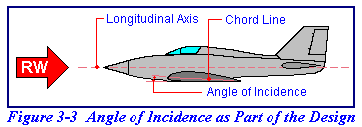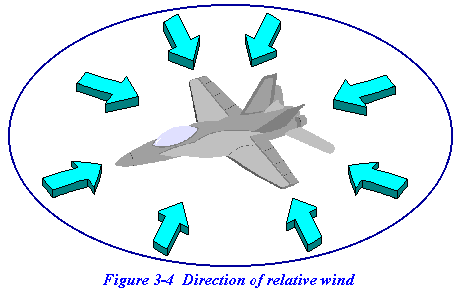 |
|||||
| Home | Research | For Teachers | HISTORY Level 1 Level 2 Level 3 |
PRINCIPLES Level 1 Level 2 Level 3 |
CAREER Level 1 Level 2 Level 3 |
| Gallery | Hot Links | What's New! | |||
| Web Administration and Tools | |||||
 |
|||||
| Home | Research | For Teachers | HISTORY Level 1 Level 2 Level 3 |
PRINCIPLES Level 1 Level 2 Level 3 |
CAREER Level 1 Level 2 Level 3 |
| Gallery | Hot Links | What's New! | |||
| Web Administration and Tools | |||||
![]()
In order to discuss how an airfoil produces lift or why it stalls, there are three terms we must understand. These are relative wind, angle of incidence, and angle of attack.
There is a noticeable motion when an object moves through a fluid or as a fluid moves around an object. If a thick stick is moved through still water or the same stick is held still in a moving creek, relative motion is produced. It does not matter whether the stick or the water is moving. This relative motion has a speed and direction.
 Now let's replace the water with air as our fluid and the stick with an
airplane as our object. Here again, it doesn't matter whether the airplane or the air is
moving, there is a relative motion called relative wind. The relative wind will be
abbreviated with the initials RW (see figure 3-3). Since an airplane is a rather large
object, we will use a reference line to help in explaining the effects of relative wind.
This reference is the aircraft's longitudinal axis, an imaginary line running from the
center of the propeller, through the aircraft to the center of the tail cone.
Now let's replace the water with air as our fluid and the stick with an
airplane as our object. Here again, it doesn't matter whether the airplane or the air is
moving, there is a relative motion called relative wind. The relative wind will be
abbreviated with the initials RW (see figure 3-3). Since an airplane is a rather large
object, we will use a reference line to help in explaining the effects of relative wind.
This reference is the aircraft's longitudinal axis, an imaginary line running from the
center of the propeller, through the aircraft to the center of the tail cone.

Note in Figure 3-4 that the relative wind can theoretically be at any angle to the longitudinal axis. However, to maintain controlled flight, the relative wind must be from a direction that will produce lift as it flows over the wing. The relative wind, therefore, is the airflow produced by the aircraft moving through the air. The relative wind is in a direction parallel with and opposite to the direction of flight.
Let's look a little closer at how relative wind affects an airplane and its wings. As shown in Figure 3-3, the chord line of the wing is not parallel to the longitudinal axis of the aircraft. The wing is attached so that there is an angle between the chord line and the longitudinal axis. (We call this difference the angle of incidence.) Since we describe relative wind (relative motion) as having velocity (speed and direction), the relative wind's direction for the wing is different from that of the fuselage. It should be easy to see that the direction of the relative wind can also be different for the other parts of the airplane.
Very briefly, angle of attack is a term used to express the relationship between an airfoil's chord and the direction of its encounter with the relative wind. This angle can be either positive, negative, or zero. When speaking of the angle of attack, we normally think of the relative wind striking the airfoil from straight ahead. In practice, however, this is true only during stabilized flight which is in a constant direction.
Send all comments to ![]() aeromaster@eng.fiu.edu
aeromaster@eng.fiu.edu
© 1995-98 ALLSTAR Network. All rights reserved worldwide.
| Funded in part by | From Civil Air Patrol Educational Materials |
Updated: February 23, 1999